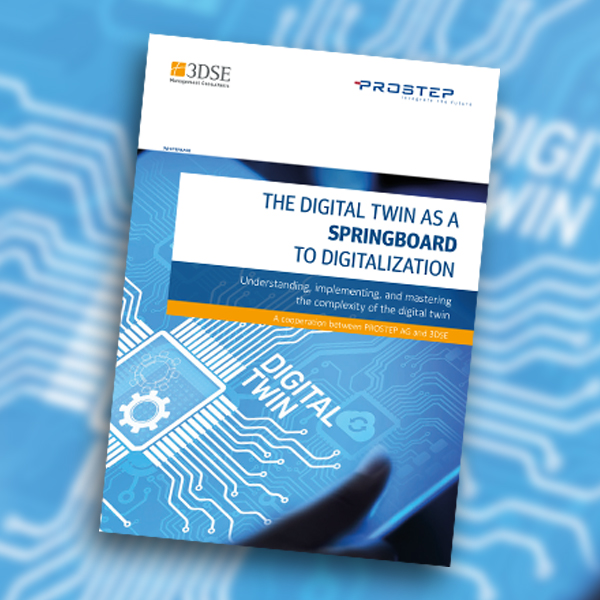
|
A reference model for developing digital twinsBy Karsten Theis Digital transformation refers to the systematic use of digital technologies to increase operational efficiency and/or develop new, data-driven business models. An important lever for increasing added value is the digital twin. A joint white paper drawn up by 3DSE and PROSTEP describes what a forward-looking digital twin concept might look like. 
The white paper summarizes the key findings of a comprehensive concept study on the digital twin, which the consultancies 3DSE and PROSTEP prepared together with Airbus Defence & Space. A key finding of this study was that existing PLM capabilities are not sufficient to make available and manage the different configurations of a digital twin for the aerospace industry. Extended PLM capabilities are required, for which the project partners have introduced the term "shared digital enterprise services". A key requirement for the digital twin is the ability to handle core data efficiently and use it for new services or the transition from a product-oriented to a service-oriented business model. Core data in this context refers to the data in its "atomic" form, i.e. in the form it is generated by the original authoring systems, as opposed to metadata, which many existing PLM infrastructures currently limit themselves to managing. The challenge when developing a digital twin is storing this data in a clearly structured manner and linking it to make interrelationships transparent. Most PLM infrastructures cannot meet this requirement because they manage only files, documents or complete models. Another problem is that PLM processes throughout the product lifecycle are usually supported in one direction only, which means that data from later lifecycle phases cannot be fed back into earlier phases. Existing PLM landscapes cover primarily conventional product data management (PDM), with functions for version and configuration management, as well as the management of formal PLM processes such as release, change management, certification and verifying compliance. In sustainable concepts, the two lower levels need to be supplemented by two additional layers with shared digital services to ensure that certain core data can be accessed. 
End-to-end digitalization plays a key role in the context of process efficiency. For example, users need to be able to exchange core data from initial systems engineering, such as the requirements relating to the individual domains mechanics, E/E and software, via different authoring systems, use this core data consistently in simulation applications or fill the authoring systems with a consistent data set for a new project or program. This requires additional PLM capabilities, which Airbus, for example, has been working on intensively for ten years. Combining old and new PLM capabilities The digital twin of products or production systems exists in different phase-specific phenotypes (as designed/as planned, as built, as operated) and in different configurations, depending on the use cases to be supported. However, these are always configurations of a generic twin and not digital twin applications that exist separately from one another. The study examined different use cases at Airbus and other companies to develop a better understanding of how the data needs to flow and what capabilities are required to make this flow of data possible. They ranged from product-as-a-service applications, in which the digital twin in combination with the operating data ensures maximum availability and reliability of the systems, to the optimization of production lines and over-the-air updates of vehicle functions through to the collection of as-manufactured data and data-driven factory management. 3DSE and PROSTEP developed a reference model for the shared digital enterprise services together with the experts from Airbus on the basis of the findings from the various use cases. It ensures the convergence of existing and new PLM capabilities. It makes the core data accessible in an integrated viewer independently of the authoring systems. The bottom layer of these shared services is semantic application integration, which ensures end-to-end digitalization of the core data. The relationships between the core data from different authoring systems are mapped in system-neutral data models that also include functions for filling the models with content. 
The layer referred to as the Configuration Referencial layer essentially comprises existing PDM/PLM functions that ensure the consistency of the configurations at file and document level. The Raw Data Storage layer is used to support digitalization and collects all the data from engineering, testing, manufacturing, operations, and the like. The Semantic Data Integration layer can then be used to establish relationships between the data for specific use cases. The reference model also provides tools and methods for a more detailed, AI-based analysis of the data. The digital twin "lives" as an information structure in the different layers of the shared digital enterprise services model, while the actual information is distributed across different authors and management systems and is used as needed. If the engineering data was stored only in the authoring systems, it would not be possible, for example, to establish references to manufacturing information that might have an impact on system behavior. Different PLM capabilities are required depending on the purpose of the digital twin. Consistent access to the data in this federated system architecture is of great importance. The key to this is the end-to-end viewing layer. Its clear organizational structure and Google-like search functions make it easy to use. It is not merely a cockpit but also a very powerful search engine that allows each person and role to choose a different entry point according to their preferences. A certain organizational structure for the different activities is required if a digital twin is to be made available for complex technical systems. In some cases, new or alternative data flows will need to be established to ensure that the digital representations remain up to date. The shared digital enterprise services presented in this white paper provide the framework for this organizational structure. If you would like to know more about our digital twin concept, you can download the white paper free of charge here. 
|
|
| © PROSTEP AG | ALL RIGHTS RESERVED | IMPRINT | PRIVACY STATEMENT | YOU CAN UNSUBSCRIBE TO THE NEWSLETTER HERE. |

